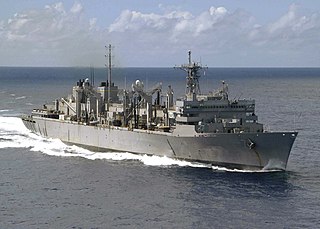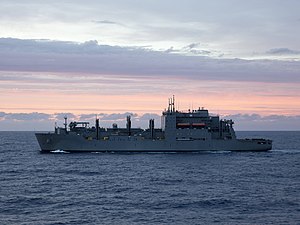
The fast combat support ship is a type of replenishment auxiliary ship. Different from traditional logistic ships, the fast combat support ship is designed with high speed to keep up with the carrier battle group/carrier strike group, while the multi-product station is capable of supplying all types of necessities for the fleet.

The Lewis and Clark class of dry cargo ship is a class of 14 underway replenishment vessels operated by the United States Navy's Military Sealift Command. The ships in the class are named after famous American explorers and pioneers.

USNS Lewis and Clark (T-AKE-1) is an American dry cargo ship, the lead ship of her namesake class. It was the second ship of the United States Navy to be named for the explorers Meriwether Lewis and William Clark. The contract to build her was awarded to National Steel and Shipbuilding Company (NASSCO) of San Diego, California, on 18 October 2001 and her keel was laid down on 22 April 2004. She was launched on 21 May 2005, co-sponsored by Jane Lewis Sale Henley and Lisa Clark, descendants of the ship's namesakes. She was delivered to the Navy on 20 June 2006.

Military Sealift Command (MSC) is an organization that controls the replenishment and military transport ships of the United States Navy. Military Sealift Command has the responsibility for providing sealift and ocean transportation for all US military services as well as for other government agencies. It first came into existence on 9 July 1949 when the Military Sea Transportation Service (MSTS) became solely responsible for the Department of Defense's ocean transport needs. The MSTS was renamed the Military Sealift Command in 1970.

USNS Arctic (T-AOE-8), formerly USS Arctic (AOE-8), is the third ship in the Supply class of fast combat support ships and is the fifth supply ship to carry the name of the region surrounding the North Pole.

USNS Observation Island (T-AGM-23) was built as the Mariner-class merchant ship Empire State Mariner for the United States Maritime Commission, launched 15 August 1953, and operated by United States Lines upon delivery on 24 February 1954, making voyages for the Military Sea Transportation Service (MSTS) until going into reserve at Mobile, Alabama on 9 November 1954.

USNS Richard E. Byrd (T-AKE-4) is a Lewis and Clark-class dry cargo ship in the United States Navy. She is the second United States Navy ship to be named after polar explorer Rear Admiral Richard E. Byrd (1888–1957).

USNS Robert E. Peary (T-AKE-5) is a Lewis and Clark-class dry cargo ship in the United States Navy. She is the fourth Navy ship named for Arctic explorer, Rear Admiral Robert E. Peary (1856–1920).

USNS Carl Brashear (T-AKE-7) is a Lewis and Clark-class dry cargo ship of the United States Navy, named in honor of Master Chief Boatswain's Mate Carl Brashear (1931–2006), one of the first African-Americans to become a US Navy Master Diver, despite having lost a leg in the 1966 Palomares incident.

USNS Wally Schirra (T-AKE-8) is a Lewis and Clark-class dry cargo ship of the United States Navy, named in honor of Captain Wally Schirra (1923–2007), one of the Mercury Seven astronauts, who flew three times in space, on Mercury 8, Gemini 6A, and Apollo 7.

USNS Soderman (T-AKR-317) is a Large, Medium-Speed Roll-on/Roll-off Ship (LMSR) and is part of the Military Sealift Command. The USNS Soderman is in the Preposition Program which stations ships across the world with military equipment. The Soderman is Watson-class vehicle cargo ship built by National Steel and Shipbuilding Company. The ship was launched on April 26, 2002 and put into service on the 24 of September 2002. The ship was named after Private First Class William A. Soderman, a Medal of Honor Recipient for World War II.

William Burdette McLean (1914–1976) was a United States Navy physicist, who conceived and developed the heat-seeking Sidewinder missile. The Sidewinder was the first truly effective air-to-air missile; its variants and upgrades are still in active service.

USNS Matthew Perry (T-AKE-9) is a Lewis and Clark-class dry cargo ship of the United States Navy, named in honor of Commodore Matthew C. Perry (1794–1858), who led the effort to open Japan to trade with the West.

SS Capella is an Algol class vehicle cargo ship that is currently maintained by the United States Maritime Administration as part of the Military Sealift Command's Ready Reserve Force (RRF). She was built as a high speed container ship by Rotterdamsche D.D.Mij N.V. in Rotterdam, Netherlands, hull no. 330, for Sea-Land Service, Inc. and named SS Sea-Land McLean, USCG ON 540413, IMO 7223508, after Sea-Land's founder Malcom McLean. Due to her high operating cost, she was sold to the United States Navy on 16 April 1982 as USNS Capella (T-AK-293).

USNS Charles Drew (T-AKE-10) is a Lewis and Clark-class dry cargo ship of the United States Navy, named in honor of Dr. Charles R. Drew (1904–1950), who developed improved techniques for blood storage, and applied his expert knowledge in developing large-scale blood banks early in World War II, saving thousands of Allied lives.

USNS Washington Chambers (T-AKE-11) is a Lewis and Clark-class dry cargo ship of the United States Navy, named in honor of Captain Washington Chambers (1856–1934), a pioneer in US naval aviation.

USNS Medgar Evers (T-AKE-13) is a Lewis and Clark-class dry cargo ship of the United States Navy. As part of the Navy's Combat Logistics Force, her mission is to deliver ammunition, provisions, dry stores, refrigerated food, spare parts, potable water, and diesel and jet fuel to U.S. Navy and allied ships while at sea. The ship is named for civil rights movement activist Medgar Evers, a World War II veteran who was assassinated in 1963. The Navy announced the naming on 9 October 2009.
The Naval Fleet Auxiliary Force is a division of the US Navy. The 42 ships of the Military Sealift Command's Naval Fleet Auxiliary Force are the supply lines to U.S. Navy ships at sea. These ships provide virtually everything that Navy ships need, including fuel, food, ordnance, spare parts, mail and other supplies. NFAF ships enable the Navy fleet to remain at sea, on station and combat ready for extended periods of time. NFAF ships also conduct towing, rescue and salvage operations or serve as floating medical facilities. All NFAF ships are government owned and crewed by civil service mariners. Some of the ships also have a small contingent of Navy personnel aboard for operations support, supply coordination and helicopter operations.

USS Carl M. Levin (DDG-120) is a United States Navy Arleigh Burke-class Flight IIA guided missile destroyer, the 70th overall for the class. The ship is named for Carl Levin, a former United States Senator and Chairman of the United States Senate Committee on Armed Services.


















